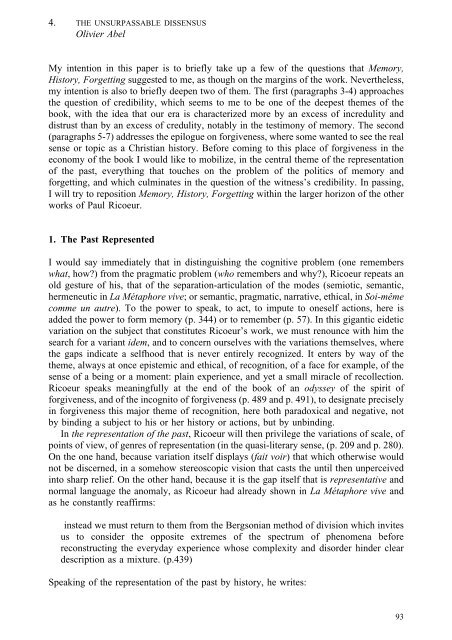[Andrzej_Wiercinski_(ed ... - WordPress.com
[Andrzej_Wiercinski_(ed ... - WordPress.com
[Andrzej_Wiercinski_(ed ... - WordPress.com
Create successful ePaper yourself
Turn your PDF publications into a flip-book with our unique Google optimized e-Paper software.
4. THE UNSURPASSABLE DISSENSUSOlivier AbelMy intention in this paper is to briefly take up a few of the questions that Memory,History, Forgetting suggest<strong>ed</strong> to me, as though on the margins of the work. Nevertheless,my intention is also to briefly deepen two of them. The first (paragraphs 3-4) approachesthe question of cr<strong>ed</strong>ibility, which seems to me to be one of the deepest themes of thebook, with the idea that our era is characteriz<strong>ed</strong> more by an excess of incr<strong>ed</strong>ulity anddistrust than by an excess of cr<strong>ed</strong>ulity, notably in the testimony of memory. The second(paragraphs 5-7) addresses the epilogue on forgiveness, where some want<strong>ed</strong> to see the realsense or topic as a Christian history. Before <strong>com</strong>ing to this place of forgiveness in theeconomy of the book I would like to mobilize, in the central theme of the representationof the past, everything that touches on the problem of the politics of memory andforgetting, and which culminates in the question of the witness’s cr<strong>ed</strong>ibility. In passing,I will try to reposition Memory, History, Forgetting within the larger horizon of the otherworks of Paul Ricoeur.1. The Past Represent<strong>ed</strong>I would say imm<strong>ed</strong>iately that in distinguishing the cognitive problem (one rememberswhat, how?) from the pragmatic problem (who remembers and why?), Ricoeur repeats anold gesture of his, that of the separation-articulation of the modes (semiotic, semantic,hermeneutic in La Métaphore vive; or semantic, pragmatic, narrative, ethical, in Soi-même<strong>com</strong>me un autre). To the power to speak, to act, to impute to oneself actions, here isadd<strong>ed</strong> the power to form memory (p. 344) or to remember (p. 57). In this gigantic eideticvariation on the subject that constitutes Ricoeur’s work, we must renounce with him thesearch for a variant idem, and to concern ourselves with the variations themselves, wherethe gaps indicate a selfhood that is never entirely recogniz<strong>ed</strong>. It enters by way of thetheme, always at once epistemic and ethical, of recognition, of a face for example, of thesense of a being or a moment: plain experience, and yet a small miracle of recollection.Ricoeur speaks meaningfully at the end of the book of an odyssey of the spirit offorgiveness, and of the incognito of forgiveness (p. 489 and p. 491), to designate preciselyin forgiveness this major theme of recognition, here both paradoxical and negative, notby binding a subject to his or her history or actions, but by unbinding.In the representation of the past, Ricoeur will then privilege the variations of scale, ofpoints of view, of genres of representation (in the quasi-literary sense, (p. 209 and p. 280).On the one hand, because variation itself displays (fait voir) that which otherwise wouldnot be discern<strong>ed</strong>, in a somehow stereoscopic vision that casts the until then unperceiv<strong>ed</strong>into sharp relief. On the other hand, because it is the gap itself that is representative andnormal language the anomaly, as Ricoeur had already shown in La Métaphore vive andas he constantly reaffirms:instead we must return to them from the Bergsonian method of division which invitesus to consider the opposite extremes of the spectrum of phenomena beforereconstructing the everyday experience whose <strong>com</strong>plexity and disorder hinder cleardescription as a mixture. (p.439)Speaking of the representation of the past by history, he writes:93


